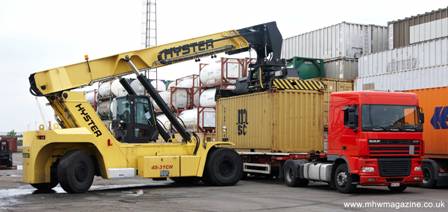
After prolonged testing by an independent user in the Benelux region, data shows that a new Hyster ReachStacker is using up to 5.7 litres (1.3 Gal) of fuel less per hour compared to competitor reachstacker models at the same container terminal.
A rental company has put the new Hyster ReachStacker into a container terminal operation in the Benelux region and observed fuel usage over a six month period. Fuel use was recorded on the new Hyster ReachStacker and on competitor reachstackers currently in operation at the same terminal.
The new Hyster ReachStacker features the Cummins QSL9 (up to 370 hp, 276kW) diesel engine and meets the requirements of Tier 4 interim(i), Stage IIIB emissions regulations and was used to gather data as part of the thorough test programme by Hyster.
Data analysis shows that the Hyster ReachStacker is using 18.8 litres per hour compared with competitor brands which are using 24.5 litres of fuel per hour while performing identical work over similar shift patterns. A difference of 5.7 litres (1.3 Gal) equates to about 23% savings at this site.
Jan-Willem van den Brand, Hyster Big Trucks Global Product Strategy Manager says "We have told the market that it is possible to achieve up to 20% fuel savings and this data from a busy terminal proves our claims. This is not theoretical, the savings are visible at the pump and in the reduced frequency of refuelling."
A representative from the undisclosed terminal stated "We believe we could save approximately EURO 60,000 a year if we were to replace all seven reachstackers at this terminal with the new Hyster ReachStacker."
Recording fuel usage was straightforward as the Hyster ReachStackers use EGR engine technology, which means diesel fuel is added to the tank as usual and the engine does the rest, unlike SCR technology (adopted by most other competitors to achieve Tier 4i compliance) which requires additives (urea).
Jan-Willem says that the fuel savings are achieved in several ways in addition to employing the Cummins engine technologies. Hyster has introduced new performance optimisation developments such as matched cooling, load sensing hydraulics, RPM management and alternate engine idle speed. Operators can also select either an HiP "high performance" or ECO-eLo "fuel efficiency" mode.
"We didn't tell the drivers about the size of the engine, they just worked with the new Hyster machine and reported lots of power and excellent performance," Jan-Willem says. The drivers experienced excellent power from the 9 litre Cummins engine because it delivers more horsepower (HP) and torque compared with the previously used 11 litre engine. There is even additional boost while revving-up thanks to the Variable Geometry Turbocharger (VGT™).
The Hyster ReachStacker has long been regarded as one of the most reliable and robust container handlers in the world. The full sliding "Vista" cab delivers a comfortable operating environment with excellent all around visibility and includes a container weight display (also showing distance and height). Due to the cooling on demand, noise levels are also kept very low with this new generation from Hyster.
The Hyster ReachStacker used in the Benelux operation is a 45-31CH model, but the company offers numerous configurations of the Hyster ReachStacker for both container handling (CH) and intermodal handling (IH), including a 6-high and 3-rows deep option.